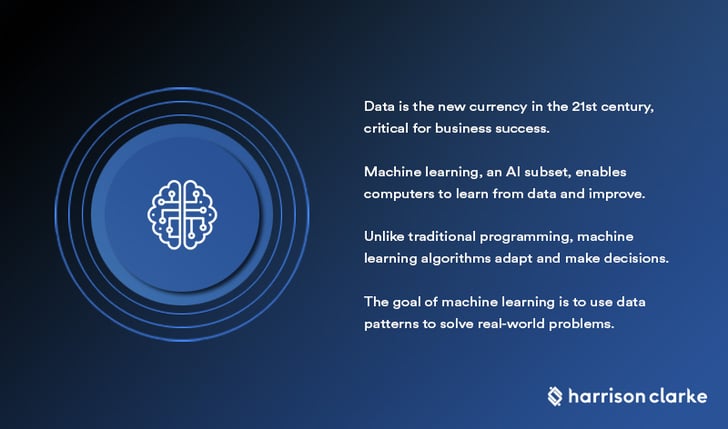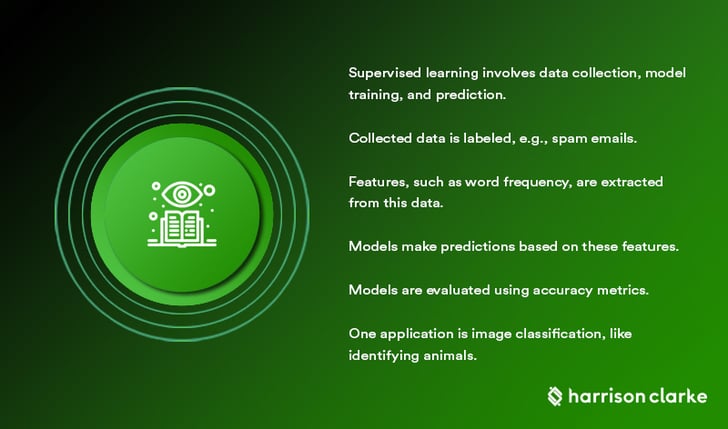In an era where data reigns supreme, the marriage of data and artificial intelligence (AI) has become a strategic imperative for businesses and organizations worldwide. Understanding the fundamental principles of machine learning is not just an option; it's a prerequisite for harnessing the power of data-driven AI applications. In this comprehensive and in-depth guide, we will embark on a journey into the world of machine learning, unraveling the key concepts, algorithms, and methodologies that underpin this transformative field. By the end of this article, you will possess a profound understanding of supervised learning, unsupervised learning, reinforcement learning, and their real-world applications. Welcome to the fascinating realm of machine learning!
The Data-Driven Revolution

In the 21st century, data has emerged as a new currency, and the ability to extract insights, make predictions, and automate decision-making from data is the cornerstone of modern business success. Machine learning is the driving force behind these data-driven AI applications, enabling computers to learn from data and improve their performance over time.
The Essence of Machine Learning
At its core, machine learning is a subset of AI that focuses on developing algorithms capable of learning from data. It empowers computers to identify patterns, make predictions, and make decisions without being explicitly programmed. This ability to learn and adapt is what sets machine learning apart from traditional programming.
Machine learning operates on the premise that patterns and relationships exist within data, and the goal is to uncover and exploit these patterns to solve real-world problems. Whether it's predicting customer preferences, detecting fraudulent transactions, or diagnosing diseases, machine learning plays a pivotal role in transforming data into actionable insights.
Supervised Learning: The Path of Guidance

1. Data Collection: The first step in supervised learning is gathering a dataset with labeled examples. For instance, in a spam email classifier, the dataset would contain emails labeled as either spam or not spam.
2. Feature Extraction: Features are extracted from the data to represent its characteristics. In the case of text data, features might include word frequency, length, or presence of specific keywords.
3. Model Training: The labeled data is used to train a machine learning model, such as a decision tree, support vector machine, or neural network. The model learns to make predictions based on the input features.
4. Model Evaluation: The model's performance is assessed using metrics like accuracy, precision, recall, and F1-score. This step ensures the model's ability to generalize to unseen data.
5. Prediction: Once trained and evaluated, the model can make predictions on new, unlabeled data. For instance, it can classify incoming emails as spam or not spam.
Real-World Application: Image Classification
One prominent real-world application of supervised learning is image classification. For example, consider a scenario where you want to develop a system that can automatically classify images of animals into different categories, such as cats, dogs, and birds. You would collect a labeled dataset of images, where each image is tagged with its corresponding category. After training, the model can accurately classify new images of animals based on what it learned during training.
Unsupervised Learning: Discovering Patterns

Unsupervised learning takes a different approach. In this paradigm, the algorithm is presented with data that lacks explicit labels or categories. Instead, its goal is to discover hidden patterns, structures, or groupings within the data.
The Unsupervised Learning Workflow
1. Data Collection: Similar to supervised learning, the process begins with gathering data. However, this time, the data lacks labels or categories.
2. Feature Extraction: Features are still extracted to represent the data, but the focus is on the inherent structure within the data itself.
3. Model Training: Unlike supervised learning, there are no labels to guide the model. Instead, the algorithm autonomously identifies patterns and relationships within the data.
4. Exploratory Analysis: After training, exploratory analysis is performed to understand the discovered patterns. Techniques like clustering (grouping similar data points) and dimensionality reduction (simplifying complex data) are commonly used.
5. Insights and Applications: The insights gained from unsupervised learning can have various applications, such as customer segmentation, anomaly detection, and recommendation systems.
Real-World Application: Customer Segmentation
Imagine you are a CMO at an e-commerce company, and you want to understand your customer base better. By applying unsupervised learning, you can analyze customer behavior data to segment your customers into distinct groups based on their preferences, buying habits, or demographics. This segmentation allows you to tailor marketing strategies and product recommendations to each group, enhancing the customer experience and boosting sales.
Reinforcement Learning: Learning by Interaction

Reinforcement learning is a paradigm of machine learning where an agent learns to make decisions by interacting with an environment. It's akin to training a dog with rewards and punishments, where the agent seeks to maximize a cumulative reward signal.
The Reinforcement Learning Framework
1. Environment: The environment represents the external system with which the agent interacts. It provides feedback in the form of rewards or penalties based on the agent's actions.
2. Agent: The agent is the learner that makes decisions and takes actions within the environment. Its objective is to maximize the cumulative reward it receives.
3. Actions: The agent selects actions from a set of available choices. The chosen actions impact the environment and influence future rewards.
4. Rewards: After each action, the agent receives a reward from the environment. The goal is to learn a policy (a strategy) that maximizes the expected cumulative reward.
5. Exploration vs. Exploitation: The agent faces a trade-off between exploring new actions to learn more about the environment and exploiting known actions that yield higher rewards.
Real-World Application: Autonomous Driving
Reinforcement learning finds compelling applications in fields like robotics and autonomous systems. Consider the case of autonomous driving, where an AI-controlled vehicle must learn to navigate safely in a complex environment. The vehicle receives rewards for obeying traffic rules, avoiding collisions, and reaching its destination. Over time, through interactions with the environment, the AI agent learns to make optimal driving decisions, ensuring passenger safety and efficiency.
The Versatility of Machine Learning: Real-World Examples

To appreciate the true versatility of machine learning, let's explore some real-world examples that demonstrate its transformative potential across various domains.
Healthcare: Disease Diagnosis
In healthcare, machine learning is revolutionizing disease diagnosis. Radiologists use deep learning models to analyze medical images (e.g., X-rays, MRIs) and identify abnormalities such as tumors or fractures. The ability to provide faster and more accurate diagnoses improves patient outcomes and reduces the burden on healthcare professionals.
Finance: Fraud Detection
In the financial sector, machine learning algorithms are deployed to detect fraudulent transactions in real-time. These models analyze transaction patterns, historical data, and user behavior to identify suspicious activities. This not only saves financial institutions billions of dollars but also enhances security for consumers.
Natural Language Processing (NLP): Language Translation
Machine learning has brought about significant advancements in natural language processing. Translation services like Google Translate leverage neural networks to provide near-instant translations between languages. This technology facilitates global communication and breaks down language barriers.
E-commerce: Personalized Recommendations
E-commerce platforms employ machine learning to offer personalized product recommendations. By analyzing user behavior and purchase history, these systems suggest products that align with individual preferences, increasing user engagement and sales.
Manufacturing: Predictive Maintenance
In manufacturing, machine learning is used for predictive maintenance. Sensors and data analytics enable companies to anticipate equipment failures before they occur, minimizing downtime and production losses.
Entertainment: Content Recommendation
Streaming services like Netflix use machine learning to recommend movies and TV shows to viewers. These recommendations are based on a user's viewing history, preferences, and behavior, enhancing the user experience.
The Future of Machine Learning

As we look to the future, the trajectory of machine learning promises continued innovation and impact across various sectors. Several key trends and advancements are poised to shape the field of machine learning:
Explainable AI (XAI)
In the quest to make AI more transparent and trustworthy, research in Explainable AI (XAI) is gaining prominence. XAI aims to provide interpretable and human-understandable explanations for AI model predictions. This is crucial in applications where decisions have significant consequences, such as healthcare and finance.
Federated Learning
Federated learning is a distributed machine learning approach that trains models across decentralized edge devices while keeping data localized. This approach respects privacy and security concerns while enabling collaborative model training.
Quantum Machine Learning
The integration of quantum computing and machine learning holds the promise of solving complex problems that are currently beyond the reach of classical computers. Quantum machine learning algorithms may revolutionize fields like cryptography, optimization, and drug discovery.
AI Ethics and Bias Mitigation
As AI becomes increasingly integrated into society, addressing ethical concerns and mitigating biases in AI systems will be paramount. Efforts to ensure fairness, transparency, and accountability in AI decision-making will continue to grow.
AutoML and Democratization
AutoML (Automated Machine Learning) tools and platforms are making machine learning more accessible to individuals and organizations with limited data science expertise. This democratization of machine learning empowers a broader audience to harness its capabilities.
Conclusion

In closing, our exploration of machine learning has taken us on a journey through its fundamental paradigms: supervised learning, unsupervised learning, and reinforcement learning. We've witnessed its transformative impact on various industries and glimpsed the exciting trends that will shape its future.
A foundational understanding of machine learning is essential in navigating the data-driven landscape of today and tomorrow. Machine learning is not just a technology; it's a driving force behind innovation, automation, and informed decision-making. Embrace the possibilities it offers, and embark on your own journey into the world of machine learning, where data becomes knowledge, and knowledge becomes power.



